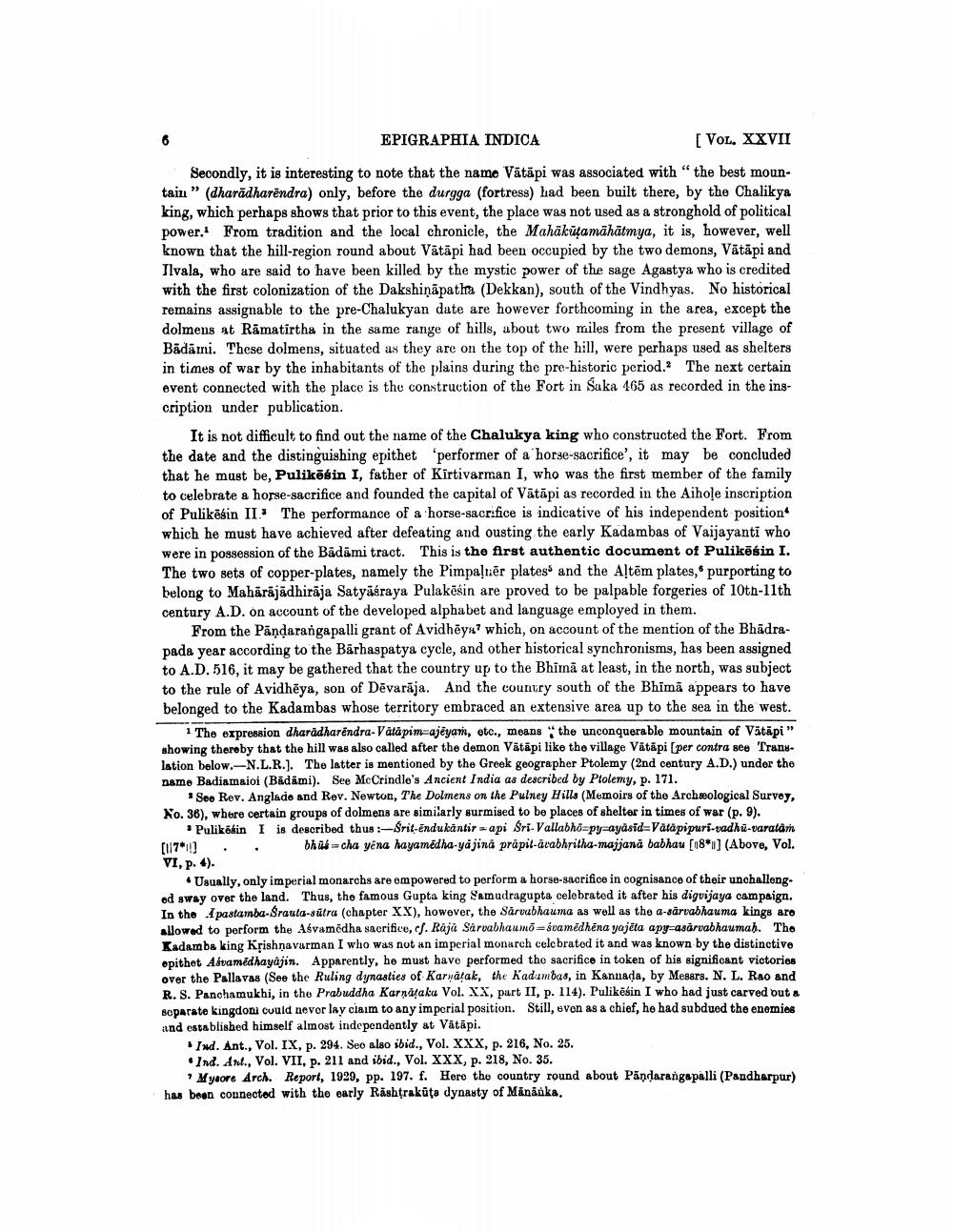________________
EPIGRAPHIA INDICA
[ VOL. XXVII
Secondly, it is interesting to note that the name Vätăpi was associated with “the best mountain " (dharādharëndra) only, before the durgga (fortress) had been built there, by the Chalikya king, which perhaps shows that prior to this event, the place was not used as a stronghold of political power. From tradition and the local chronicle, the Mahākūtamāhātmya, it is, however, well known that the hill-region round about Vätāpi had been occupied by the two demons, Vātāpi and Ilvala, who are said to have been killed by the mystic power of the sage Agastya who is credited with the first colonization of the Dakshinapatla (Dekkan), south of the Vindhyas. No historical remains assignable to the pre-Chalukyan date are however forthcoming in the area, except the dolmens at Rāmatirtha in the same range of hills, about two miles from the present village of Bădărni. These dolmens, situated as they are on the top of the hill, were perhaps used as shelters in times of war by the inhabitants of the plains during the pre-historic period. The next certain event connected with the place is the construction of the Fort in Saka 465 as recorded in the inscription under publication.
It is not difficult to find out the name of the Chalukya king who constructed the Fort. From the date and the distinguishing epithet 'performer of a horse-sacrifice', it may be concluded that he must be, Puliköbin I, father of Kirtivarman I, who was the first member of the family to celebrate a horse-sacrifice and founded the capital of Vātāpi as recorded in the Aihoļe inscription of Pulikēģin II: The performance of a horse-sacrifice is indicative of his independent position which he must have achieved after defeating and ousting the early Kadambas of Vaijayanti who were in possession of the Bädāmi tract. This is the first authentic document of Pulikēsin I. The two sets of copper-plates, namely the Pimpaļlier plates and the Altēm plates, purporting to belong to Mahārājādhirāja Satyasraya Pulakēģin are proved to be palpable forgeries of 10th-11th century A.D. on account of the developed alphabet and language employed in them.
From the Pandarangapalli grant of Avidhēya? which, on account of the mention of the Bhädrapada year according to the Bärhaspatya cycle, and other historical synchronisms, has been assigned to A.D. 516, it may be gathered that the country up to the Bhima at least, in the north, was subject to the rule of Avidhēya, son of Dēvarāja. And the country south of the Bhimă appears to have belonged to the Kadambas whose territory embraced an extensive area up to the sea in the west.
1 The expression dharadharëndra-Vatãpim-ajēyan, etc., means the unconquerable mountain of Vätäpi” showing thereby that the hill was also called after the demon Vätapi like the village Våtápi (per contra see Translation below.-N.L.R.). The latter is mentioned by the Greek geographer Ptolemy (2nd century A.D.) under the name Badiamaioi (Badami). See McCrindle's Ancient India as described by Ptolemy, p. 171.
See Rev. Anglado and Rev. Newton, The Dolmens on the Pulney Hills (Memoirs of the Archeological Survey, No. 36), where certain groups of dolmens are similarly surmised to be places of shelter in times of war (p. 9).
Pulikokin I is described thus:-Srit-Endukantir = api Sri-Vallabho=py-ayasid=Vatapipuri-vadhi-varalam (117*!]
bhu-cha yena hayamēdha-ya jiná prápil-avabhritha-majjand babhau [189] (Above, Vol. VI, p. 4).
Usually, only imperial monarchs are empowered to perform a horse-sacrifice in cognisance of their unchalleng. od gway over the land. Thus, the famous Gupta king Samudragupta celebrated it after his digvijaya campaign. In the pastamba-Srauta-sútra (chapter XX), however, the Sarvubhauma as well as the a-sarvabhauma kings aro allowed to perform the Afvamodha sacrifice, cf. Raja Sarvabhaumā=svamēdhëna yajita apy-asārvabhaumah. The Kadamba king Krishnavarman I who was not an imperial monarch celcbratod it and was known by the distinctive epithet Advamedhayajin. Apparently, he must have performed tho sacrifice in token of his significant victories over the Pallavas (See the Ruling dynasties of Karnatak, the Kadumbas, in Kannada, by Mesars. N. L. Rao and R. S. Panchamukhi, in the Prabuddha Karnaku Vol. XX, part II, p. 114). Pulikeáin I who had just carved out a separate kingdoni ovuld never lay claim to any imperial position. Still, avon as a chief, he had subdued the enemies and established himself almost independently at Vätäpi.
Ind. Ant., Vol. IX, p. 294. See also ibid., Vol. XXX, p. 216, No. 25. Ind. dr., Vol. VII, p. 211 and ibid., Vol. XXX, p. 218, No. 35.
Mysore Arch. Report, 1929, pp. 197. f. Here the country round about Pandarangapalli (Pandharpur) has been counected with the early Rashtrakūta dynasty of Manauka.




